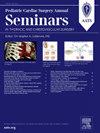最新进展:复杂的肺动脉外周重建技术
Q2 Medicine
引用次数: 0
摘要
在过去的几年里,我们发展并改进了需要肺动脉重建的TOF-PA-MAPCA和其他形式的肺动脉外周狭窄(PPAS)患者的手术方法。PPAS是一种相对罕见的先天性心脏病,通常与遗传综合征(如Williams综合征或Alagille综合征)有关。我们不再采用分阶段入路在所有病例中都使用中线切口。目前,我们已经对近1000例TOF-PA-MAPCA或广泛的双侧PPAS患者进行了手术。早期死亡率从2.1% (3/145 PPAS)到4.9% (38/780 TOF-PA-MAPCA,总队列)。在我们的TOF-PA-MAPCA队列中,早期死亡的独立因素是Alagille综合征(HR 2.8, 95% CI: 1.4-5.7;P & lt;0.004),任何术前呼吸支持(HR 2.0, 95% CI: 1.2-3.3;P & lt;0.008),以及本中心既往姑息性手术(HR 3.5, 95% CI: 2.3-5.4;P & lt;多变量Cox回归分析0.001)。90%(704/780)的患者实现了完全的心内修复。这篇文章报道了我们肺动脉重建的手术方法,并强调了一些关键的概念。我们的手术策略基本上适用于所有TOF-PA-MAPCA或PPAS患者。本文章由计算机程序翻译,如有差异,请以英文原文为准。
State of the Art: Complex Peripheral Pulmonary Artery Reconstruction Techniques
Over the last several years, we developed and improved our surgical approach to patients requiring pulmonary artery reconstruction in the setting of TOF-PA-MAPCA and other forms of peripheral pulmonary artery stenosis (PPAS). PPAS is a relatively rare form of congenital heart disease and typically associated with genetic syndromes, such as Williams or Alagille syndromes. We no longer do a staged approach and use a midline incision in all cases.
We have now operated on almost 1000 patients with TOF-PA-MAPCA or extensive bilateral PPAS. Early mortality ranges from 2.1% (3/145 PPAS) to 4.9% (38/780 TOF-PA-MAPCA, total cohort). In our TOF-PA-MAPCA cohort, independent factors for early mortality were Alagille syndrome (HR 2.8, 95% CI: 1.4-5.7; P < 0.004), any preoperative respiratory support (HR 2.0, 95% CI: 1.2-3.3; P < 0.008), and previous palliative surgery at our center (HR 3.5, 95% CI: 2.3-5.4; P < 0.001) on multivariable Cox regression analysis. Complete intracardiac repair was achieved in 90% (704/780) of this cohort.
This document reports our surgical approach to pulmonary artery reconstruction with emphasis on certain key concepts. Our surgical strategy is applicable to essentially every patient with TOF-PA-MAPCA or PPAS.
求助全文
通过发布文献求助,成功后即可免费获取论文全文。
去求助
来源期刊

Pediatric Cardiac Surgery Annual
Medicine-Surgery
CiteScore
3.80
自引率
0.00%
发文量
7
期刊介绍:
The Pediatric Cardiac Surgery Annual is a companion to Seminars in Thoracic and Cardiovascular Surgery . Together with the Seminars, the Annual provides complete coverage of the specialty by focusing on important developments in pediatric cardiac surgery. Each annual volume has an expert guest editor who invites prominent surgeons to review the areas of greatest change in pediatric cardiac surgery during the year. Topics include 1) Complete Atrioventricular Canal; 2) New Concepts of Cardiac Anatomy and Function -- The Helical Heart; 3) Valve Reconstruction (Replacement) in Congenital Heart Disease; 4) Evolving Developments in Congenital Heart Surgery.
 求助内容:
求助内容: 应助结果提醒方式:
应助结果提醒方式:


